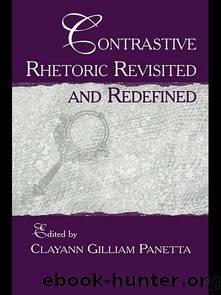Contrastive Rhetoric Revisited and Redefined by Panetta Clayann Gilliam;

Author:Panetta, Clayann Gilliam;
Language: eng
Format: epub
Tags: Education
Publisher: Taylor & Francis Group
Published: 2000-11-01T00:00:00+00:00
Curriculum Design
Traditionally, undergraduate courses in technical communication (and many masterâs-level courses as well) have focused more on the definitive âhow-toâ approach than on the exploratory, analytical approach. Students are taught how to write in various genres: the technical memo, proposal, report, user manual, and so forth. As a result, students move into the work world understanding how to prepare a report that follows a set rhetorical pattern appropriate for the generic U.S. audience: Introduction, Scope of the Project, Discussion, Conclusions, Recommendations, Appendix. But they are rarely taught methods for discovering the nature of genres in situations with multiple cultures and contrasting rhetorical expectations.
For example, when communicating project information from one culture to another, engineers should not assume they need to pull out the standard formats and fill in the blanks. Instead, they should take the time to learn about the people they are communicating to and discuss with them the form that would be most useful for them. It may be a long report, or it may be a series of short memos, or it may be a conversation with key people. They need to have in their repertoire the tools to create any of these forms, but they should not assume that specific genres work in cross-cultural communication. Nonetheless, in all likelihood that is the only approach they have been taught.
In standard technical communication courses across the country, we have privileged the teaching of forms over the teaching of strategies for successfully conveying information. Even though we pay lip service to audience analysis and spend a significant portion of our classes teaching the document planning process, most of us still concentrate on getting students to understand how to write specific types of documents for specific situations, and we are often frustrated to see in our classrooms so many non-native English speakers who do not have the cultural schemas we believe are necessary to produce effective (i.e., English) technical documents.
Although it is true that technical communication teachers have long urged students to inquire about their audiences prior to writing, most of the approaches to doing so depend on rigid forms. The audience-analysis questionnaires students are often asked to complete do not get to the heart of rhetorical difference, nor do they allow writers to explore meaningfully the commonalities and differences among the parties in a rhetorical situation. Instead, they ask the standard questions about education level, familiarity with the product, possible resistances to the information to be conveyed, and so on. The answers to these questions do not help to define the audienceâs cultural expectations or provide sufficient information to allow for real communication design. Further, most students who complete such questionnaires do so as a rote activity with no incentive to discover information that will determine their own rhetorical choices. They view the results as helpful only to decide how to arrange the standard report components: Should x come before or after y, and should a be expanded while b is shortened?
The key to productive change in our pedagogical methods is to avoid rigid perspectives and assumptions that are culture-bound.
Download
This site does not store any files on its server. We only index and link to content provided by other sites. Please contact the content providers to delete copyright contents if any and email us, we'll remove relevant links or contents immediately.
Cecilia; Or, Memoirs of an Heiress — Volume 1 by Fanny Burney(32080)
Cecilia; Or, Memoirs of an Heiress — Volume 3 by Fanny Burney(31471)
Cecilia; Or, Memoirs of an Heiress — Volume 2 by Fanny Burney(31422)
The Lost Art of Listening by Michael P. Nichols(7172)
We Need to Talk by Celeste Headlee(5422)
Asking the Right Questions: A Guide to Critical Thinking by M. Neil Browne & Stuart M. Keeley(5369)
On Writing A Memoir of the Craft by Stephen King(4674)
Dialogue by Robert McKee(4167)
Pre-Suasion: A Revolutionary Way to Influence and Persuade by Robert Cialdini(3988)
I Have Something to Say: Mastering the Art of Public Speaking in an Age of Disconnection by John Bowe(3784)
Elements of Style 2017 by Richard De A'Morelli(3239)
The Book of Human Emotions by Tiffany Watt Smith(3149)
Fluent Forever: How to Learn Any Language Fast and Never Forget It by Gabriel Wyner(2923)
Name Book, The: Over 10,000 Names--Their Meanings, Origins, and Spiritual Significance by Astoria Dorothy(2849)
Good Humor, Bad Taste: A Sociology of the Joke by Kuipers Giselinde(2827)
Why I Write by George Orwell(2783)
The Grammaring Guide to English Grammar with Exercises by Péter Simon(2649)
The Art Of Deception by Kevin Mitnick(2627)
Ancient Worlds by Michael Scott(2501)
